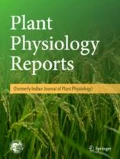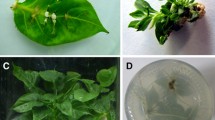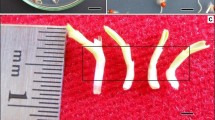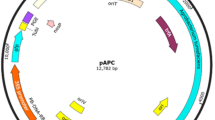Abstract
In this study, we have describe a highly efficient transformation protocol for two elite Indian cultivars of chilli pepper (Capsicum annuum L.), Pusa Sadabahar and Pusa Jwala. We used hypocotyls and cotyledons derived from young seedlings as explants, standardized regeneration medium for enhanced regeneration, and optimized parameters for promoting efficient transformation in these chilli cultivars. The optimized regeneration medium consisting of MS medium augmented with 1 mg l−1 indole-3-acetic acid and 5 mg l−1 6-benzyl amino purine induced profuse shoot regeneration from the hypocotyl and cotyledon explants, with a regeneration frequency of 81% in Pusa Sadabahar and 78% in Pusa Jwala. The transformation protocol was standardized using Agrobacterium tumefaciens strain LBA4404 harbouring pCAMBIA2301 construct with GUS reporter and NPT-II marker genes. The results demonstrated that the hypocotyl explants are more amenable to transformation than cotyledonary explants in both the cultivars studied. Further, co-cultivation of the hypocotyl explants with agrobacterial cells (OD600 = 0.2–0.5) for the duration of 72 h was found to be optimum for obtaining high transformation efficiency of about 30% in both the cultivars. The transgenic status of chilli transformants recovered in the selection medium having 30 mg l−1 kanamycin was confirmed by GUS activity, PCR, Southern and RT-PCR analyses. About 85–90% of rooted transgenic plants survived hardening and acclimatization processes. Using this protocol we produced several independent transgenic lines of each chilli cultivar.





Similar content being viewed by others
References
Ahmad, N., Siddique, I., & Anis, M. (2006). Improved plant regeneration in Capsicum annuum L. from nodal segments. Biologia Plantarum, 50(4), 701–704.
Belletti, P., Marzachi, C., & Lanteri, S. (1998). Flow cytometric measurement of nuclear DNA content in Capsicum (Solanaceae). Plant Systematic and Evolution, 209, 85–91.
Christopher, T., & Rajam, M. V. (1996). Effect of genotype, explants and medium on in vitro regeneration of red pepper. Plant Cell, Tissue and Organ Culture, 46, 245–250.
Csillery, G. (2006). Pepper taxonomy and the botanical description of the species. Acta Agronomica Hungarica, 54(2), 151–166.
Delis, M., Garbaczewska, G., & Niemirowicz-szczytt, K. (2005). Differentiation of adventitious buds from capsicum annuum L. hypocotyls after co-culture with Agrobacterium tumefaciens. Acta Biologica Cracoviensia Series Botanica, 47/1, 193–198.
Doyle, J. J., & Doyle, J. L. (1990). Isolation of plant DNA from fresh tissue. Focus, 12, 13–15.
FAO—Food and Agriculture Organization of the United Nations. (2014). FAOSTAT database, USA. www.fao.org/faostat/en.#data/QC/visualize. Accessed 22 Feb 2017
Gunay, A., & Rao, P. S. (1978). In vitro plant regeneration from hypocotyl and cotyledon explants of red pepper (Capsicum). Plant Science Letter, 11, 365–372.
Jefferson, R. A., Kavanagh, T. A., & Bevan, M. W. (1987). GUS fusions: B-glucuronidase as a sensitive and versatile gene fusion marker in higher plants. EMBO Journal, 6(13), 3901–3907.
Joshi, A., & Kothari, S. L. (2007). High copper levels in the medium improves shoot bud differentiation and elongation from the cultured cotyledons of Capsicum annuum L. Plant Cell, Tissue and Organ Culture, 88, 127–133.
Ke, J., Khan, R., Johnson, T., Somers, D. A., & Das, D. (2001). High-efficiency gene transfer to recalcitrant plants by Agrobacterium tumefaciens. Plant Cell Reports, 20, 150–156.
Kehie, M., Kumaria, S., & Tandon, P. (2012). In vitro plantlet regeneration from nodal segments and shoot tips of Capsicum chinense Jacq. cv. Naga King Chili. 3Biotech, 2, 31–35.
Ko, M. K., Soh, H., Kim, K., Kim, Y. S., & Im, K. (2007). Stable production of transgenic pepper plants mediated by Agrobacterium tumefaciens. HortScience, 42(6), 1425–1430.
Kumar, R. V., Sharma, V. K., Chattopadhyay, B., & Chakraborty, S. (2012). An improved plant regeneration and Agrobacterium—mediated transformation of red pepper (Capsicum annuum L.). Physiology and Molecular Biology of Plants, 18(4), 357–364.
Lee, Y. H., Kim, H. S., Kim, J. Y., Jung, M., Park, Y. S., Lee, J. S., et al. (2004). A new selection method for pepper transformation: Callus-mediated shoot formation. Plant Cell Reports, 23, 50–58.
Lee, S. J., Kim, B. D., & Paek, K. H. (1993). In vitro plant regeneration and Agrobacterium-mediated transformation from cotyledon explants of hot pepper (Capsicum annuum L. cv. Golden Tower). Korean Journal of Plant Tissue Culture, 20, 289–294.
Li, D., Zhao, K., Xie, B., Zhang, B., & Luo, K. (2003). Establishment of a highly efficient transformation system for pepper (Capsicum annuum L.). Plant Cell Reports, 21, 785–788.
Liu, W., Parrott, W. A., Hildebrand, D. F., Collins, G. B., & Williams, E. G. (1990). Agrobacterium-induced gall formation in bell pepper (Capsicum annuum L.) and formation of shoot-like structures expressing introduced genes. Plant Cell Reports, 9, 360–364.
Maligeppagol, M., Manjula, R., Navale, P. M., Babu, K. P., Kumbar, B. M., & Laxman, R. H. (2016). Genetic transformation of chilli (Capsicum annuum L.) with Dreb1A transcription factor known to impart drought tolerance. Indian Journal of Biotechnology, 15, 17–24.
Manoharan, M., SreeVidya, C. S., & Lakshmi, S. G. (1998). Agrobacterium-mediated genetic transformation in hot chilli (Capsicum annuum L. var. Pusa jwala). Plant Science, 13, 77–83.
Mok, S. H., & Norzulaani, K. (2007). Trouble shooting for recalcitrant bud formation in Capsicum annuum var. Kulai. Asia Pacific Journal of Molecular Biology and Biotechnology, 15, 33–38.
Murashige, T., & Skoog, F. (1962). A revised medium for rapid growth and bioassay with tobacco tissue cultures. Physiologia Plantarum, 15, 473–497.
Prakash, D. P., Deepali, B. S., Asokan, R., Ramachandra, Y. L., Anand, L., & Hanur, V. S. (2007). Effects of growth regulators and explant-type on Agrobacterium-mediated transformation in brinjal (Solanum melongena L.) cv. Manjarigota. Journal of Horticulture Science, 2, 94–98.
Prakash, Α. Η., Rao, Κ. S., & Kumar, Μ. U. (1997). Plant regeneration from protoplasts of Capsicum annuum L. cv. California Wonder. Journal of Bioscience, 22, 339–344.
Ramirez-Malagon, R., & Ochoa-Alejo, N. (1996). An improved and reliable chili pepper (Capsicum annuum L.) plant regeneration method. Plant Cell Reports, 16, 226–231.
Ray, S., Kapoor, S., & Tyagi, A. K. (2011). Analysis of transcriptional and upstream regulatory sequence activity of two environmental stress-inducible genes, NBS-Str1 and BLECStr8, of rice. Transgenic Research, 21, 351–366.
Sambrook, J., Fritsch, E. F., & Maniates, T. (1989). Molecular cloning: A laboratory manual (2nd ed.). New York: Cold Spring Harbor Laboratory Press.
Steinitz, B., Wolf, D., Matzevitch-Josef, T., & Zelcer, A. (1999). Regeneration in vitro and genetic transformation of pepper (Capsicum spp.): The current state of the art. Capsicum and Eggplant Newsletter, 18, 9–15.
Verma, S., Dhiman, K., & Srivastava, D. K. (2013a). Efficient in vitro regeneration from cotyledon explants in bell pepper (Capsicum annuum L. Cv. California wonder). International Journal of Advanced Biotechnology and Research, 4(3), 391–396.
Verma, S., Dhiman, K., & Srivastava, D. K. (2013b). Agrobacterium-mediated genetic transformation of bell pepper (Capsicum annuum L. Cv. California wonder). International Journal of Advanced Biotechnology and Research, 4(3), 397–403.
Wilkinson, J. E., Twell, D., & Lindsey, K. (1997). Activities of CaMV 35S and nos promoters in pollen: Implications for field release of transgenic plants. Journal of Experimental Botany, 48, 265–275.
Acknowledgements
The research work was financed by the Department of Biotechnology (Grant No. BT/PR5399/AGR/36/722/2012), Government of India, to SD and MVR. BKM gratefully acknowledges Department of Science and Technology-INSPIRE (DST-INSPIRE), Government of India, for providing fellowship.
Author information
Authors and Affiliations
Corresponding authors
Additional information
Poonam Sharma and Swatismita Dhar-Ray: Formerly associated with TERI.
Rights and permissions
About this article
Cite this article
Mahto, B.K., Sharma, P., Rajam, M.V. et al. An efficient method for Agrobacterium-mediated genetic transformation of chilli pepper (Capsicum annuum L.). Ind J Plant Physiol. 23, 573–581 (2018). https://doi.org/10.1007/s40502-018-0389-1
Received:
Accepted:
Published:
Issue Date:
DOI: https://doi.org/10.1007/s40502-018-0389-1




